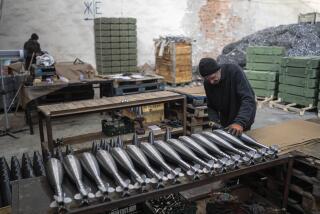Russia’s Dilemma: Deficit vs. Decline : Transition: While the government struggles to keep hyper-inflation at bay, factories plead for help to stay afloat.
- Share via
TULA, Russia — Vladimir Dronov, boss of more than 10,000 workers at the Tula combine factory, stands on the production floor of a monster plant the size of several football fields. All the machinery is still.
“It’s so frustrating,” he sputters, looking at an assembly line that could be putting out thousands of tractors a month if he only had the money to pay for the raw materials. “The state credits don’t go to the right places. . . . All we’re asking for is normal credit conditions.”
In his pleas for government subsidies to float his foundering factory, the rotund director personifies the great dilemma facing Russia today.
What to do about Dronov? What to do about the thousands of factories that demand government money to survive this period of economic chaos and transition to a free market?
“It’s a decision worthy of Solomon,” said Roman Khutoretsky of the Russian government’s new panel on industrial policy.
If it subsidizes the Dronovs, the government adds to the giant budget deficit that now has Russia on the verge of hyper-inflation--price rises of more than 50% a month. If it tells the Dronovs to muddle through on their own, it faces a further drop in industrial production added to last year’s disastrous 20% decline.
“We must walk a tightrope between hyper-inflation and everything that is linked to it, on the one hand, and the catastrophic production slump and mass unemployment on the other,” Boris Fyodorov, Russia’s top economic overseer, told the weekly Moscow News.
The subsidy dilemma reflects a deeper Russian economic problem as well: the legacy of decades of central planning that produced thousands of factories making unprofitable, or unneeded, goods with increasingly decrepit and polluting equipment.
These plants must be retooled and geared to the market, but in the meantime, if left to their own devices, at least 30% of the country’s factories would be considered bankrupt, government officials estimate. Until now, not one has formally gone under.
When Russia’s new prime minister, Viktor Chernomyrdin, took office in December, he announced that fighting industrial collapse was his first priority. He started out with a bang--a 200-billion-ruble injection, about $320 million, to the natural gas industry.
But then he began to back away from shoring up industry at any cost.
Many observers believe that it was the subsidy issue that brought down Chernomyrdin’s predecessor, Yegor Gaidar. His initial strict resolve to balance the budget was slowly worn away by pleas and pressure from factory directors, each seeking special help, and he let inflation slip out of control.
It has reached the point, Fyodorov said, that the government is printing a trillion rubles a month--about $1.6 billion--just to support credits to industry and agriculture.
Chernomyrdin has now publicly resolved to be different.
“It would be wrong to give away cheap credits and subsidies,” he told parliament in his first report. “We cannot afford to squander money.”
Ask Dronov, however, if lending him 2 or 3 million government dollars at reasonable interest rates amounts to squandering money.
“We could put out 20,000 or 30,000 combines,” he said. “We could have the conveyors ready in a month.”
The Tula combine factory, with its designs for a new mini-tractor ready for large-scale production, could give Russia’s new, small-scale private farming a real boost, improving critically needed food supplies.
“We just need the money to buy materials,” Dronov said. “And there’s no money, because of non-payments.”
Non-payments are the several billion dollars that Russian factories, suppliers and retailers owe each other and are unable to pay--either because the banking system is so gummed up that it can take months to transfer money or because their own customers have not paid them.
Dronov, for example, owes more than $1 million to his suppliers, and his customers owe him almost $2 million.
Because his main customer, Rost-SelMash, the massive harvester factory in Rostov, has not paid a cent since November, Dronov has stopped sending it the giant six-yard-long blades he makes for it. So they litter the factory’s extensive grounds like bright orange modern sculptures, and he has no money to pay his metal suppliers.
And neither can he borrow it. Commercial banks, he said, charge him up to 200% interest on loans, making them a last resort to which he turns only when cash runs out for workers’ salaries.
But for all his complaints--including an impassioned speech that impatient lawmakers cut off at the last Congress of People’s Deputies--Dronov has gotten no help from the government.
“It’s all politics,” he said. A recent statement from Chernomyrdin confirmed that charge.
“We will not repeat the mistakes of the recent past,” the prime minister said, “in which the size of the credits and subsidies doled out depended on the pressure exerted by the directors of industries and individual factories.”
Part of the subsidy problem is that so very many products are of critical importance, and the Gaidar government could not decide which came first.
Asked what industries had been receiving special government help, Vladimir Alyoshin of the government’s Industrial Economy Department said: “We gave money to the energy and heating complex, to factories that earn hard currency, to agricultural products and factories that make agricultural machinery, to the food-processing industry, to base sectors like metallurgy. . . .”
He could have gone on and on.
Now, according to the new government policy Chernomyrdin announced, subsidies will go only to individual projects deemed worthy of help. The new industrial policy panel on which Khutoretsky serves was created this fall in part to help decide where money should go.
The Russian government “needs to define whom we support and whom we don’t and what niches we want to fill on the world market,” Fyodorov said.
Under the new policy, directors such as Dronov should find it even harder to get cheap government credits and loans. They also could face being fired by the government if they are shown to be managing the factory badly, price-gouging or giving bonuses instead of investing.
Khutoretsky, told about Dronov’s plans for mini-tractors, sounded unexcited. Plenty of other factories are planning to, or are already beginning to, produce mini-tractors, he said, and Dronov should find foreign partners if he needs investment.
Directors prefer government loans, he said, because they are not only cheaper but are frequently forgiven altogether. But the old dependence on the state, conditioned into producers for decades, must be broken.
Dronov is willing to get along without the credits. He has still not laid off any employees, although the plant closed for more than a week during the New Year’s and Christmas holidays. The workers earn better than average wages--about $15 a month--and busy themselves producing parts for tractors they hope will be ordered, or turning out other consumer goods the factory has taken on.
And the Tula combine factory seems far too big for the government to allow it to close down altogether.
“But if they gave us credits,” Dronov said, “we’d do everything twice as fast.”
More to Read
Sign up for Essential California
The most important California stories and recommendations in your inbox every morning.
You may occasionally receive promotional content from the Los Angeles Times.










